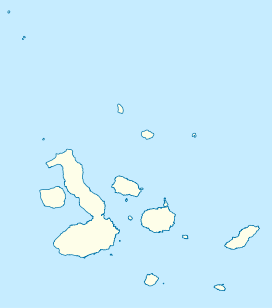North Seymour Island
 North Seymour Island | |
| Geography | |
|---|---|
| Location | Galápagos Islands, Ecuador |
| Coordinates | 0°23′44″S 90°17′14″W / 0.395592°S 90.287327°WCoordinates: 0°23′44″S 90°17′14″W / 0.395592°S 90.287327°W |
| Archipelago | Galápagos Islands |
| Highest elevation | 28 m (92 ft) |
| Administration | |
North Seymour (Spanish: Isla Seymour Norte) is a small island near Baltra Island in the Galápagos Islands. It was formed by uplift of a submarine lava formation. The whole island is covered with low, bushy vegetation.
The island is named after an English nobleman, Lord Hugh Seymour. North Seymour Island has an area of 1.9 square kilometres (0.73 sq mi) and a maximum altitude of 28 metres (92 ft). This island is home to a large population of blue-footed boobies and swallow-tailed gulls. It hosts one of the largest populations of magnificent frigatebirds (Fregata magnificens) and a slow growing population of the Galápagos land iguanas (Conolophus subcristatus).
North Seymour has a visitor trail approximately 2 kilometres (1.2 mi) in length crossing the inland of the island and exploring the rocky coast.
The stock for the captive breeding program of the Galápagos land iguana is descended from iguanas which Captain G. Allan Hancock translocated from nearby Baltra Island to North Seymour Island in the 1930s. This was very important because Baltra Island had a U.S airbase on it during World War II, while North Seymour, which has no people who live on it, and is only viewable today with an official guide who works for the Galápagos National Park.
North Seymour was created by seismic uplift, rather than being of volcanic origin. The island has a flat profile with cliffs only a few meters from the shoreline, where swallowtail gulls and tropicbirds sit perched in ledges. A tiny forest of silver-grey Palo Santo trees stand just above the landing, usually without leaves, waiting for rain to bring them into bloom. The island is teeming with life. While visiting the island, one may have to give way to a passing sea lion or marine iguana. Flocks of pelicans and swallow-tailed gulls feed off shore, and seasonally, Nazca boobies can also be seen.
North Seymour is an extraordinary place for breeding birds, and is home to one of the largest populations of nesting blue-footed boobies and magnificent frigate birds. Pairs of blue-footed boobies can be seen conducting their mating ritual as they offer each other gifts, whistle and honk, stretch their necks towards the sky, spread their wings, and dance—showing off their bright blue feet. Magnificent frigatebirds perch in low bushes, near the boobies, while watching over their large chicks. The frigates are huge, dark aerobats with a 90-inch (2.3 m) wingspan. Male frigates can puff up their scarlet throat sacks to resemble giant red balloons. Boobies and frigates have an interesting relationship. Boobies are excellent hunters and fish in flocks. The frigates by comparison are pirates, they dive bomb the boobies to force them to drop their prey. Then, the aerobatic frigate swoops down and picks up the food before it hits the water.

Additional images
| Wikimedia Commons has media related to North Seymour Island. |
- A Galápagos land iguana on the North Seymour Island in the Galápagos
- (Sula nebouxii) blue footed booby on North Seymour Island Galápagos
- Beach in North Seymour Island, Galápagos
- Long view of the beach on North Seymour Island, Galápagos
 Galápagos sea lion (Zalophus wollebaeki)
Galápagos sea lion (Zalophus wollebaeki)- North Seymour Island in the Galápagos
- North Seymour Island Galápagos seal with baby
- North Seymour Island in the Galápagos about to land on shore. Daphne Island is in the distance.
- North Seymour Island in the Galápagos, Daphne Island is in the distance.
- North Seymour Island in the Galápagos, a bird in flight
- North Seymour Island in the Galápagos
- A baby bird at North Seymour Island in the Galápagos
- Magnificent frigatebird (Fregata magnificens) in flight on the coast of North Seymour Island in the Galápagos
- Magnificent frigatebird, North Seymour Island
- North Seymour Island
 The beach at North Seymour Island in the Galápagos North. Daphne Island is in the distance.
The beach at North Seymour Island in the Galápagos North. Daphne Island is in the distance. North Seymour, Galapagos, land iguana
North Seymour, Galapagos, land iguana